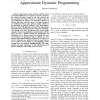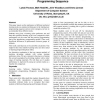853 search results - page 27 / 171 » Dyslexia and learning computer programming |
112
click to vote
CDC
2010
IEEE
14 years 7 months ago
2010
IEEE
Approximate policy iteration methods based on temporal differences are popular in practice, and have been tested extensively, dating to the early nineties, but the associated conve...
111
click to vote
SIGCSE
2002
ACM
15 years 2 days ago
2002
ACM
This paper reports on the implication of different preferred learning styles on students'performance in the introductory programming sequence and on work in progress on how t...
118
Voted
GECCO
2007
Springer
15 years 6 months ago
2007
Springer
An agent population can be evolved in a complex environment to perform various tasks and optimize its job performance using Learning Classifier System (LCS) technology. Due to the...
80
Voted
ICML
2008
IEEE
16 years 1 months ago
2008
IEEE
We consider the task of learning to accurately follow a trajectory in a vehicle such as a car or helicopter. A number of dynamic programming algorithms such as Differential Dynami...
117
click to vote
KDD
2007
ACM
16 years 25 days ago
2007
ACM
The kernel function plays a central role in kernel methods. In this paper, we consider the automated learning of the kernel matrix over a convex combination of pre-specified kerne...


